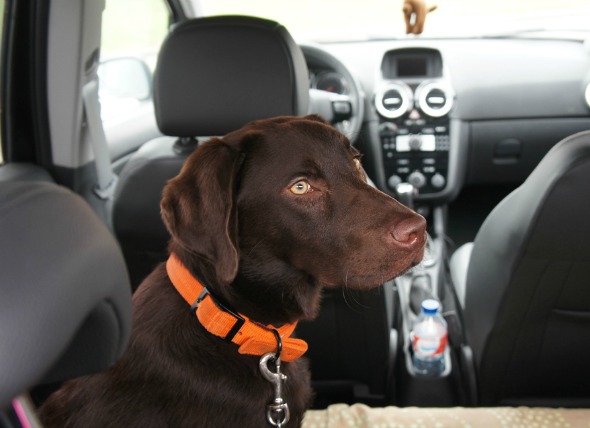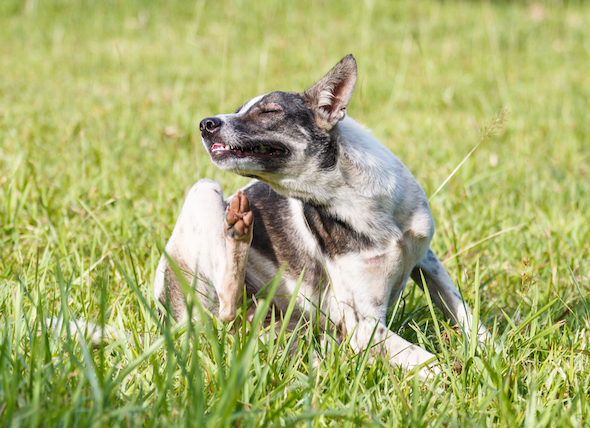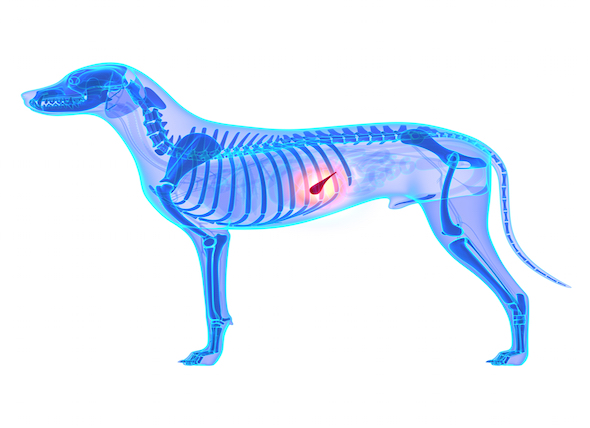
Dogs communicate with each other in many ways. One of the ways they use is through smell, or scent. Each dog's urine and feces has a unique scent. When dogs urinate or defecate in specific locations (territory marking), they are communicating with other dogs that may come along later. These scented leavings act as messages for other dogs that come along, telling them which dog has been in a specific area, and that this dog has claimed the area as its territory. Dogs first begin this territorial marking behavior as they become mature. For male dogs it takes place around puberty, and for female dogs it takes place around the time they go into heat for the first time. When dogs reach puberty, they also become more likely to stray away from the home. This is called roaming. Dogs will roam to find mates, to explore, and to mark their territory. Dogs that are not spayed or neutered are more likely to roam and mark territory than dogs that have been neutered or spayed.
You will need to provide a complete medical and behavioral history leading up to the onset of your dog's marking and roaming behavior. Along with a thorough physical examination, your veterinarian will order the standard tests: a complete blood count, biochemical profile, and urinalysis. These tests will help your doctor to determine whether there is an underlying medical condition, such as a bladder infection, which might be causing your dog's symptoms. Further tests may include a blood thyroid test to make sure that your dog’s thyroid level is normal, and fecal (stool) tests to rule out intestinal parasites or nutritional deficiency.
If the urine analysis shows that your dog has a bladder infection, your veterinarian may order a culture of the urine and x-rays of your dog's bladder. The culture will show exactly what bacteria are causing the bladder infection, and x-ray images will show the presence of bladder stones, or other bladder problems, which might be causing the bladder infection.
If you have a female dog that is not spayed, your veterinarian may also do a vaginal cytology, a lab analysis of the cells in the vagina so that the stage of estrus (heat) she is in can be determined. If all of these tests return normal, your dog will be diagnosed with a behavioral problem.
If a medical problem is found that is causing your dog to mark territory excessively, or roam away from home, this problem will be treated first. This alone may help decrease some of the behavior. If your dog is not spayed or neutered, your veterinarian will recommend spaying or neutering unless you have plans to breed your dog. This often helps to decrease roaming and marking behavior. If your dog has been diagnosed with a behavioral problem, your veterinarian will help to guide you through a plan to change that behavior (behavioral modification therapy). This plan will typically involve changes to your daily routine with your dog.
If you are having a problem with your dog roaming, it may help to increase the amount of exercise that your dog gets every day. Playing with your dog several times a day and walk your dog every day on a leash can spend a lot of energy and prevent your dog from becoming physically frustrated. Ideally, a securely fenced back yard where your dog can play is best, but if you cannot provide that, and you have concluded that your dog is not doing well inside the house for long periods of the day, you may choose to place your dog in a “doggie day care,” at least on occasion, so that your dog is getting a break from the daily wait for your return home. Dog day care centers often have large spaces in which dogs can play, and this may help increase your dog's activity level and give it in outlet to expend its energy. If your pet roams because of separation anxiety or fear, your veterinarian will help you to come up with a program of behavior training to help your dog deal with its anxiety. In some cases, medication may be necessary to help your dog to calm down and get over this problem.
If your dog has a problem with marking, it may help to keep other animals away from your house and yard. If your pet dog has been urinating or defecating in your home, it is important to thoroughly clean those areas with a special cleaner that will remove the odor thoroughly. After cleaning, you should not allow your dog into these areas again until the behavioral training has firmly set in. One other option is to use synthetic animal pheromones in the home to dissuade your dog from marking. These man-made versions of natural dog smells will cause your dog to think that the territory has already been marked and will not mark them again with urine. You veterinarian can tell you more about this and other options that will stop your dog's marking behavior.
When you first begin behavioral modification therapy, your veterinarian will want to check your progress regularly. This is to address any issues that might have come up and to make sure that you and your dog are doing well with the planned therapy. If your dog is on medication for anxiety, you will need to return to the veterinarian’s office for follow-up complete blood counts and biochemistry levels to make sure the medication is not damaging any of your dog’s internal organs.
Because marking and roaming are normal dog behaviors, they may take some time to change and to stop entirely. Your dedication to the behavioral training will be the crucial determinant for a successful outcome. Keep in mind the importance of training your dog not to follow this instinctive urge: when roaming, your dog could be in a dog fight or could be hit by a car, or it could be harmed or stolen by people who chance upon it.
Of the most common reasons people give their dogs up to animal shelters, urinating or defecating in the home and frequently running off are two that are highly concerning. The stress that these behaviors bring into the home make behavioral training to eliminate them highly important. Be patient with your dog and use a lot of positive reinforcement as it learns to behave better for you.
Whatever treatment plan you and your veterinarian come up with, this is the plan that will need to be followed consistently for the rest of your dog’s life. This will keep your dog from returning to the inappropriate behavior. If your dog is being treated for anxiety, it may need to be on medication for a long time. Some dogs can eventually be weaned off medication, while others may not be resolved as easily.
Spaying female dogs before their first heat cycle, and neutering male dogs before they reach puberty can prevent a lot of questionable behaviors. Making sure that your dog gets plenty of daily activity is essential for it's physical and mental health.
 Dogs and Motion Sickness
Gastrointestinal Distress Related to Motion in Dogs
&nbs
Dogs and Motion Sickness
Gastrointestinal Distress Related to Motion in Dogs
&nbs
 Muscle Contraction Disease (Myoclonus) in Dogs
Myoclonus in Dogs
The term "myoclonus"
Muscle Contraction Disease (Myoclonus) in Dogs
Myoclonus in Dogs
The term "myoclonus"
 Bacterial Infection (Pyoderma) of the Skin in Dogs
Pyoderma in Dogs
When a dog's skin is cut or
Bacterial Infection (Pyoderma) of the Skin in Dogs
Pyoderma in Dogs
When a dog's skin is cut or
 Inflammation of the Pancreas in Dogs
Pancreatitis in Dogs
The pancreas is part of the
Inflammation of the Pancreas in Dogs
Pancreatitis in Dogs
The pancreas is part of the
 Anemia Due to Bone Marrow Failure (or Toxicity) in Dogs
Aplastic Anemia in Dogs
Bone marrow plays a pivot
Anemia Due to Bone Marrow Failure (or Toxicity) in Dogs
Aplastic Anemia in Dogs
Bone marrow plays a pivot
Copyright © 2005-2016 Pet Information All Rights Reserved
Contact us: www162date@outlook.com